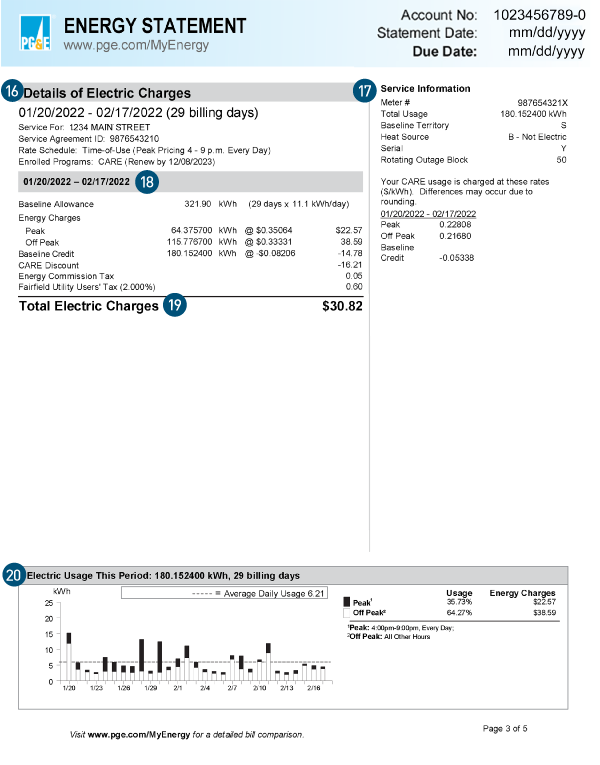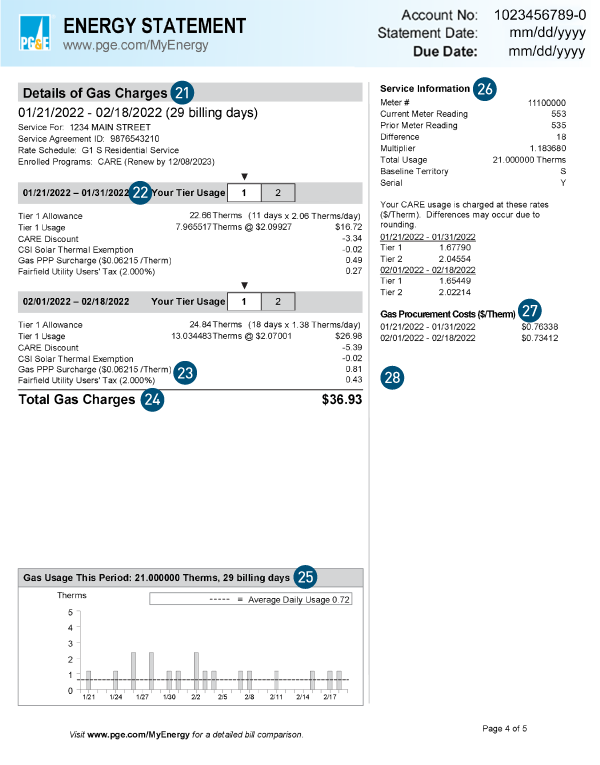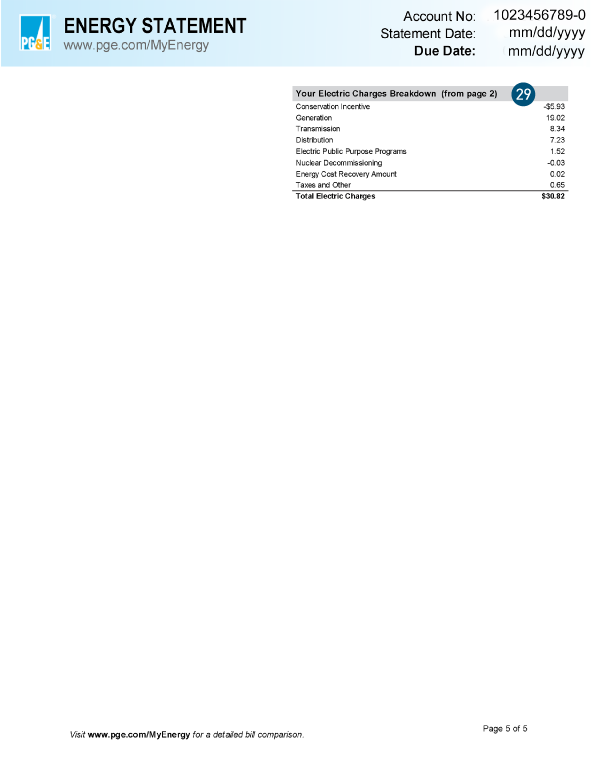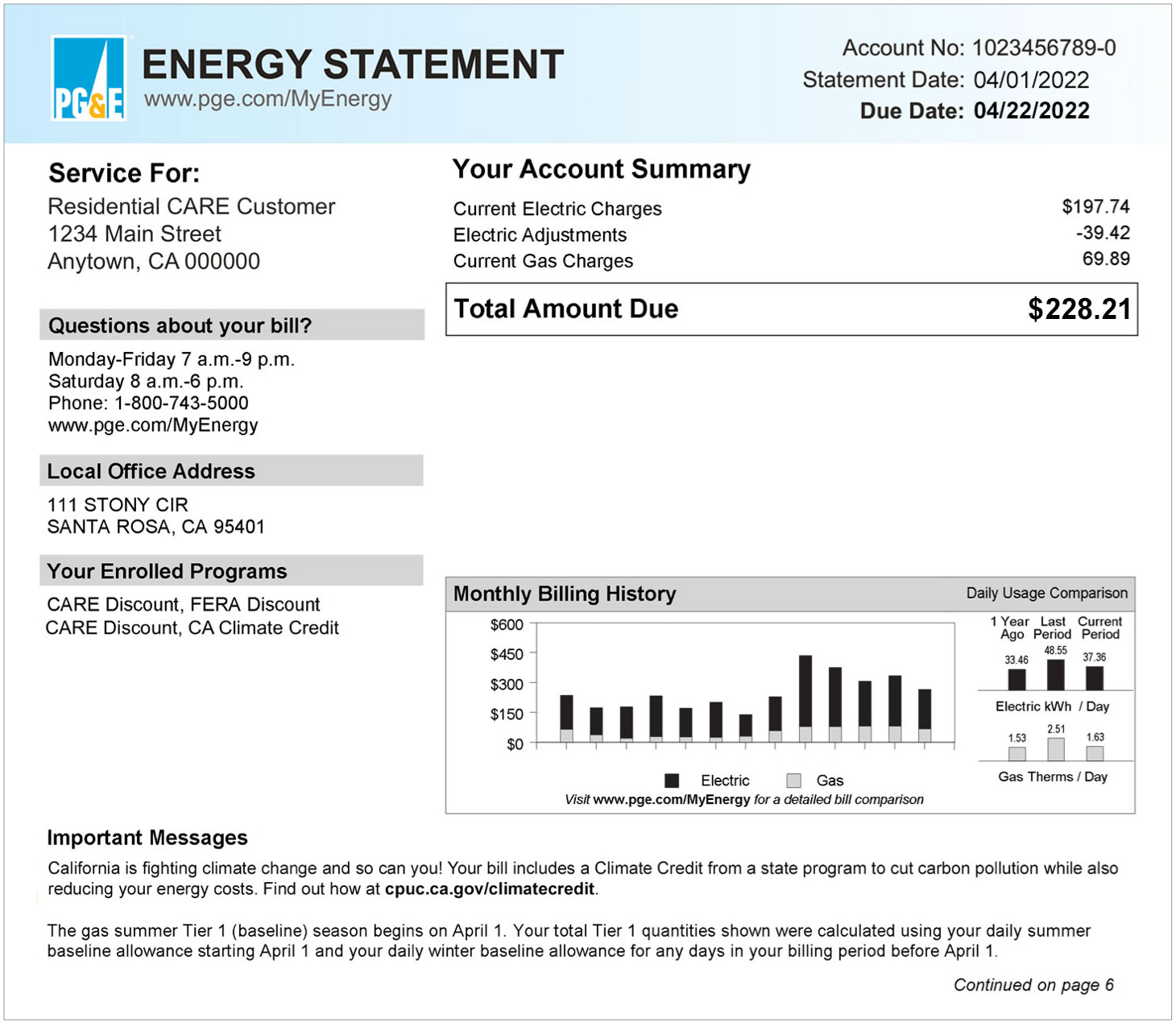Error: Field cannot left blank.
Error: Invalid entry. Do not use equal signs [=] or colons [:].
Error: Field cannot left blank.
Error: Invalid entry. Do not use equal signs [=] or colons [:].
Understanding your bill
Find out what impacts your bill with this breakdown. Learn how you can manage your monthly bill and save energy.
Your bill contains
- Monthly energy charges
- At-a-glance account data
- Your account number
- Statement date (top of page every page)
- Due date (top of page every page)
- Account summary
- Your payments and charges are printed in large font.
- Usage graphs
- A monthly billing history graph charts your daily energy usage.
- Bill inserts
- Details on rebates
- Energy-saving tips
- Gas and electric safety information
- If you don't receive a paper bill, go to bill inserts online.
How to read your bill

1. "Account No.": Have this 10-digit number ready to call us about your energy use. Each active account receives a separate monthly statement.
2. "Service For": Where your charges were incurred.
3. "Your Account Summary": An overview of charges incurred, payments received and your total amount due.
4. "Questions about your bill?": Contact us by phone or online.
5. "Total amount due": Your payment due date and charges.
6. Notes. This space is for notes related to programs or details that affect your bill total.
7. "Your Enrolled Programs": Programs you are enrolled in that may impact your bill total.
8. "Monthly Billing History": A chart of your monthly charges over the past year—based on "Bill From" and "Bill To" dates.
9. "Important Messages": Timely information from PG&E.
10. Payment Stub: Return this form with your payment to the address indicated.

11. "Important Phone Numbers": Use customer service phone numbers when online options are unavailable.
12. "Rules and rates": Learn about the rules for disputing charges. Go to the CPUC's complaint page.
13. "Important definitions": Key terms you should know. Also, visit definitions.
14. "Update My Information": Always inform us if your contact information changes.
15. "Ways to Pay": You have many options to pay your PG&E bill. Learn more about ways to pay.

16. "Details of Electric Charges": Your billing dates, the address at which electricity was received, your service agreement ID number (not your account number—
they’re different), rate plan and enrolled programs.
17. "Service information": Details about your electric meter. Your meter tracks your electricity usage.
18. Electricity usage: Information about your electricity usage during billing dates
- Kilowatt (kWh) hours are the units used to measure your electric use. You are billed based on how many kWh hours you use each month.
- Energy used during 'peak' hours is charged at a higher rate than energy that is used during 'part peak' and 'off peak' hours.
19. "Total Electric Charges": The total charges for your electric use, including any credits and applicable taxes.
20. "Electric Usage This Period": Use this chart to visually understand when you are using more energy.

21. "Details of Gas Charges": Your billing dates, the address at which gas was received, your service agreement ID number (not your account number— they're different), rate plan and enrolled programs.
22. Gas usage: Information about your gas usage during billing dates
- Therms are the units used to measure your gas use. You are billed based on how much gas, in therms, you use each month.
- Customers on certain rate plans are charged a fixed fee for service. This fixed fee is not affected by the amount of energy consumed or charges based on usage.
23. Taxes and fees: State and local governments may place taxes and fees on your energy use.
24. "Total Gas Charges": The total charges for your gas use, including any credits and applicable taxes.
25. "Gas Usage this Period": This daily usage chart shows which days you used the most gas this month.
26. "Service Information": Details about your gas meter. Your meter tracks your gas usage.
27. "Gas Procurement Cost": The meter at your home tracks your gas usage. The utility's cost to buy natural gas and transport it to its local pipeline system. The price usually changes on the first business day of each month.
28. Additional messages: PG&E uses this space to share timely information, ranging from summer safety tips to regulatory updates.

29. "Your Electric Charges Breakdown": Line items on your electric bill. Have a question about a line item? Visit a complete list of key terms and their definitions.
Manage your bill
Explore bill management
Compare your bill and view energy usage
Understand your home or business energy use by comparing your bill history.
Frequently asked questions
1. Cutting costs and improving operational efficiencies
- PG&E works to keep future bill impacts at or below assumed inflation (2 to 4 percent).
- PG&E generates more than $970 million by selling licensing agreements to wireless providers to attach equipment to transmission towers.
- PG&E moves powerlines underground to reduce recurring maintenance costs.
- PG&E pursues federal funding to offset costs of making the energy system safer and more climate resilient.
- PG&E has saved $4.9 billion by streamlining how we plan our work and resources and renegotiating older contracts.
2. Helping you manage your energy use and costs
We are determined to help you save money on your bill no matter your income level. We provide resources, tools and rebates to make sure you are on the best rate for your household and to lower your energy usage.
3. Offering financial assistance programs if you are having a difficult time paying your bill:
- Automatically enrolling all residential and small business customers with past due balances over 60 days in new extended payment arrangements.
- Relief for Energy Assistance through Community Help (REACH) offers one time energy credit financial assistance to qualified customers with past due bills.
- Low-Income Home Energy Assistance Program (LIHEAP) offers up to $1,000 to pay eligible household energy costs.
- Arrearage Management Program (AMP) offers up to $8,000 in unpaid balance forgiveness, if a customer is enrolled in the California Alternate Rates for Energy (CARE) program or Family Electric Rate Assistance (FERA) program, owes a specific bill amount and is more than 90 days past due.
We have given credits totaling $548 million to 654,000 customers from the state’s California Arrearage Payment Program. This helped to lower past-due balances as a result of the COVID-19 pandemic.
4. Working with our partners on ways to lower energy costs
- Requesting federal funds to help with some of the costs of making our infrastructure more climate resilient.
- Advocating with our regulator and state lawmakers to make energy bills more predictable, simplified and affordable.
Energy bills can go up or down for a variety of reasons beyond your control like the weather, state regulations and commodity prices.
Rest assured we do not:
- Control the market prices for gas and electricity.
- Mark up the cost of the gas and electricity that we purchase on behalf of our customers.
- Make more money when our customers use more gas or electricity. This is called decoupling.
- Encourage customers to use more energy. Our profits do not come from the energy we sell.
We make a profit on:
- The cost of building infrastructure (like powerlines) that delivers energy
- How efficiently we run our business
- Lowering our customers' energy use
There are a few things you can control that may affect your bill, such as:
- The amount of energy you use
- When you choose to use energy
- Your rate plan
- Enrolling in bill discount programs that you are eligible for
Rate changes
Our gas and electric rates can change several times each year and are expected to increase overall in 2023.
All changes in rates need to be approved by the California Public Utilities Commission (CPUC). The CPUC regulates utilities like PG&E. These changes include:
- Increases in the cost of purchasing gas and electricity
- Maintaining our pipes and wires
The money from these rate increases allows us to support critical investments and programs that:
- Make the electric grid and gas system safer and more reliable
- Reduce wildfire risk
- Enable energy efficiency and renewable energy
- Provide eligible, low-income customers with discounted energy bills
Annual gas and electric rate change
Customer gas and electric rates changed on January 1, 2023, as part of an annual process called the “true-up” authorized by the California Public Utilities Commission. These rate changes include charges for:
- Gas and electric delivery
- Electricity supply
- State-mandated assistance programs for income-qualified customers, energy efficiency and public-interest research and development.
As part of this year’s true-up, average residential non-CARE gas bills decreased by 4.6 percent. This does not include natural gas supply costs.
Average residential non-CARE electric (non-Community Choice Aggregator or Direct Access) bills increased by approximately 3.4 percent.
The California Public Utilities Commission (CPUC) regulates and approves the price of energy and all rates paid by customers.
We determine the revenue we need to serve customers safely and reliably and then propose what rate should be charged to recover that money from customers.
Rates are set in formal meetings that are open to public participation and comments.
Regulatory oversight
When we need to make any rate change, we submit an application to the CPUC.
The application describes the upgrade required or a new program or service. It also includes the costs and impact on rates.
- Our application is reviewed in a public forum and by stakeholders such as:
- Groups representing residential and business customers
- Low-income and community advocates
- Environmental groups
- Agricultural interests and others
- The CPUC issues a decision on the basis of what is just and reasonable for customers to pay in rates.
Once approved, we incorporate the changes into rates.
We file every four years for the CPUC to review and authorize revenues collected for certain electric generation and distribution and natural gas transmission, storage and distribution operations costs.
That process is called the General Rate Case for electric and gas.
In addition to the CPUC, the Federal Energy Regulatory Commission approves the retail electric transmission portion of rates.
A typical residential electric bill includes:
- Energy Cost (50%): What we pay to produce and buy electricity from solar or wind providers and other power plants on behalf of our customers. We do not markup these costs.
- Energy Delivery (40%): Operating and maintaining the electric system including power poles, powerlines and associated equipment.
- Public Purpose Programs (10%): Mandated by the state for the greater societal good, including energy efficiency and low-income customer assistance.
A typical residential gas bill includes:
- Energy Cost (20%): What we pay to buy natural gas on behalf of our customers. We do not markup these costs.
- Energy Delivery (70%): Operating and maintaining the gas system including infrastructure like natural gas pipelines that deliver gas to your home or business.
- Public Purpose Programs (10%): Mandated by the state for the greater societal good, including programs for energy efficiency, renewable energy and low-income customer assistance.
Weather and climate play a role in determining your bill. Energy usage is generally higher in warmer climates in the summer and in colder climates in the winter leading to seasonally higher bills.
Customers receive a baseline allowance of energy available at the lowest price. This is based on where they live, their heating source and the season (summer or winter).
- Customers living in hotter areas receive more electricity at the lowest rate due to home and business-cooling needs.
- Customers living in colder winter climates receive more gas at the lowest rate for their heating needs.
We offer programs and tips to help customers with higher bills due to climate.

We are investing in new technologies and modernizing the electric and gas systems so that our transition to clean energy can be safe, reliable, and affordable. The money you pay:
- Buys or generates some of the cleanest electricity in the country—96% comes from greenhouse gas-free sources.
- Strengthens power poles and powerlines to reduce the impacts of extreme weather and natural disasters.
- Develops new energy efficiency programs to help you save energy.
- Invests in new innovations, like battery storage and microgrids, so that you have access to clean energy when you need it most.
Your safety is our most important responsibility
The threat of extreme weather and wildfires is real. Our Community Wildfire Safety Program helps protect our communities from the risk of wildfires 365 days a year.
We are making the system safer and stronger so when extreme weather happens, we will continue to be ready for it:
- Keeping trees and branches away from powerlines
- Undergrounding 10,000 miles of powerlines in highest fire-risk areas
- Ensuring safety with enhanced protection and temporary outages
- Installing stronger powerlines and poles
- Using the latest technologies and equipment
A cleaner energy future
California is leading the way to a cleaner energy future. Over 96% of our power is already greenhouse-gas-free.
- Solar rooftops
- More connected in our service area than any energy company in America
- Investing in the grid that makes widespread adoption of electric vehicles possible
- Battery energy storage
- Deploying more so that our customers can access clean and reliable renewable energy—even when the sun isn't shining or the wind isn't blowing, and at night
- Deploying more so that our customers can access clean and reliable renewable energy—even when the sun isn't shining or the wind isn't blowing, and at night
- Emissions
- Implementing plans to greatly reduce emissions created by our company and our customers by 2030. This is equal to taking more than 3.2 million passenger vehicles off the road for one year.
- Implementing plans to greatly reduce emissions created by our company and our customers by 2030. This is equal to taking more than 3.2 million passenger vehicles off the road for one year.
A state of innovation
California is the fifth largest economy in the world and a state of innovators and changemakers.
We are:
- Working with the world’s leading car manufacturers on a new program that will enable electric vehicles to become portable power plants for homes and businesses when the power is out.
- Partnering with clean energy leaders. We built and are operating one of the world's largest battery storage facilities, so that you have access to energy when you need it.
- Building microgrids to keep power on where it is safe to do so during power outages, and remote grids so that even our most vulnerable communities will have power during extreme weather.
A more reliable system
To support the growing and changing energy needs of our customers, while helping our state reach its climate and clean energy goals, we are:
- Upgrading the energy grid
- Re-inspecting thousands of miles of powerlines
- Moving 10,000 miles of electric lines underground in highest fire risk areas
- Trimming vegetation even farther back from powerlines
- Working with first responders and communities to protect the most vulnerable
To serve our 4.6 million natural gas customers safely and reliably, we:
- Operate a state-of-the-art 50,000-mile pipeline system
- Modernized our natural gas system extensively
- Replaced more than 2,000 miles of gas transmission and distribution pipeline
- Retired cast iron within our system
- Utilize advanced technologies to monitor our system around the clock from our 24-hour Gas Control Center
Economic development
In 2020—the 40-year anniversary of our Supplier Diversity Program—we invested $3.88 billion with diverse suppliers.
Our overall supplier diversity goal is 40 percent, including 25 percent with minority-owned businesses through 2023.
As one of the largest employers in California—more than 24,000 employees—we have a responsibility to help everyone thrive and prosper.
- Our partnerships with small and diverse businesses increase economic opportunities in our hometowns. Women, minority, service-disabled veterans, and LGBT-owned businesses play an important role in helping us deliver energy service to our customers.
- Our economic development experts help businesses:
- Choose the right location
- Evaluate real estate costs, availability, fees and taxes
- Find money-saving business solutions
- Answer questions about labor costs and supplies
Frequently used words
The following key words and definitions may appear on your PG&E energy statement.
Baseline Allowance: Your rate plan may include a baseline allowance. This consists of an allotment of electricity available at the lowest price based on where you live, your heating source and the season (summer or winter).
Baseline Credit: Your rate plan may include a baseline credit. This is a discount on the per kilowatt-hour price for electricity usage below the monthly baseline allowance.
Baseline Territory: Area in which the PG&E service territory is divided. The PG&E service territory is divided into Climate Zones or “baseline territories.” The California Public Utility Commission (CPUC) bases Tier 1 gas and electric prices on the average amount of energy consumed by customers within each baseline territory.
Bundled Service Customer: Full-service customer who purchases both PG&E energy delivery services and energy generation. This customer type differs from a customer who purchases energy from a third-party energy service provider.
CA Climate Credit: Credit on your energy statement. This represents your share of payments from a state program requiring power plants, natural gas distributors and other large industries that emit greenhouse gases to buy carbon pollution permits. The California Public Utilities Commission (CPUC) created this program and oversees its implementation. Visit California Climate Credit.
Competition Transition Charges (CTC): Charge for legacy electricity contracts, signed prior to 1998, that exceed a CPUC-approved market price limit.
Connected Load Charge: Demand charge based on the capacity rating of the pumps connected to the meter.
Conservation Incentive Adjustment: A component of your electric charges designed to reflect tiered residential pricing. It provides a credit to customers who primarily use within the baseline (Tier 1), and a charge for all other usage.
Customer Charge: Fixed fee for service that customers on certain rate plans are charged. The charge is not dependent on the amount of energy consumed, or based on usage.
Demand Charge: Charge included in many non-residential rates. Demand is a measurement of the highest usage of electricity in any single 15-minute (or sometimes 5-minute) period during a monthly billing cycle. Demand is measured in kilowatts (kW). High demand is usually associated with equipment start-up. By spreading equipment start-ups over a longer period, you may be able to lower demand and reduce your demand charges.
Distribution Charge: Charge for the lower-voltage system of power lines, poles, substations and transformers directly connecting PG&E distribution lines to homes and businesses.
DWR Power Charge: Recovers the cost of bonds issued by the Department of Water Resources (DWR) to purchase power to serve electric customers during the California energy crisis. DWR bond charges are collected on behalf of DWR and do not belong to PG&E.
Energy Commission Tax: Tax that PG&E collects to fund the California Energy Commission based on electric use during a billing period.
Energy Cost Recovery Amount (ECRA): Charges imposed pursuant to law to help reduce the costs of financing the PG&E emergence from bankruptcy. One of these charges is the Dedicated Rate Component (DRC). The right to receive DRC revenues was sold to a special purpose entity: the PG&E Energy Recovery Funding LLC. PG&E is collecting this charge on behalf of PG&E Recovery Funding LLC. The charge does not belong to PG&E.
Franchise Fee: Surcharge that pays cities and counties for the right to use public streets to provide utility services. PG&E collects the surcharges and passes them to cities and counties. This tax (if any) is charged as a percentage of your energy charges.
Gas Core Procurement Cost: Utility’s cost to buy natural gas and transport the gas to its local transmission system. The price typically changes on the first business day of each month.
Generation Charges: Cost of creating electricity to power your home or business.
Heat Source: Primary heating source that is permanently installed in a home.
Meter Charge: Meter charge to recover the additional equipment costs of providing customers with some time-of-use electric rates.
Meter Constant: Factor that converts electric meter read differences to kilowatt-hours (kWh).
Multiplier: Factor that converts the gas meter read difference to Therms. The multiplier corrects for differences in elevation, delivery pressure and the heating content of natural gas.
Nuclear Decommissioning: Fee to restore closed nuclear plant sites to as near their original condition as possible.
Power Charge Indifference Adjustment (PCIA): The PCIA is a charge to ensure that both PG&E customers and those who have left PG&E service to purchase electricity from other providers pay for the above market costs for electric generation resources that were procured by PG&E on their behalf. ‘Above market’ refers to the difference between what the utility pays for electric generation and current market prices for the sale of those resources. Visit pge.com/cca.
Public Purpose Programs: Funding programs considered by law to benefit society, such as low-income ratepayer assistance and energy efficiency.
Recovery Bond Charge/Credit: Your bill for electric service includes a charge that has been approved by the CPUC to repay bonds issued for certain costs related to catastrophic wildfires. The Recovery Bond Charge (RBC) rate is currently $0.00597 per kWh. PG&E has also contributed certain amounts to a trust fund which is used to provide a customer credit equal to $0.00597 per kWh (Recovery Bond Credit). The right to recover the RBC has been transferred to one or more Special Purpose Entities that issued the bonds and does not belong to PG&E. PG&E is collecting that portion of the RBC on behalf of the Special Purpose Entities.
Rotating Outage Block: Number that indicates the order in which your power is interrupted in the event of a power emergency that causes the California Independent System Operator to implement rotating outages.
Serial: Serial code that determines when a meter is read for billing. Visit the meter reading schedule to find your meter reading dates.
SF Prop C Tax Surcharge: PG&E collects this tax as required by San Francisco’s Proposition C and applies to all San Francisco customers, regardless of service provider.
Solar Choice Program: Solar Choice is a program that enables bundled customers to purchase solar energy to match either 50% or 100% of their energy use without the need for onsite installation. Learn more at community renewables and review the current tariff (PDF).
Time-of-Use Electric Rate Plan: Plan with higher rates for energy on weekday or weekend afternoons and evenings and lower rates at other times. Prices also change by season, with higher prices in the summer and lower prices in the winter. This means that when you use energy is just as important as how much you use.
Transmission: Cost of transmitting electricity from power plants, over high-voltage lines and towers, to the distribution system.
Utility Users Tax (UUT): Tax that PG&E collects for a city or county government. The tax (if any) is a percentage of your energy charges.
Wildfire Fund Charge: Charge on behalf of the State of California department of Water Resources (DWR) to fund the California Wildfire Fund. For usage prior to October 1, 2020, this charge included costs related to the 2001 California energy crisis, also collected on behalf of the DWR. These charges belong to DWR, not PG&E.
Wildfire Hardening Charge: PG&E has been permitted to issue bonds that enable it to recover more quickly certain costs related to preventing and mitigating catastrophic wildfires, while reducing the total cost to its customers. Your bill for electric service includes a fixed recovery charge called the Wildfire Hardening Charge that has been approved by the CPUC to repay those bonds. The right to recover the Wildfire Hardening Charge has been transferred to a separate entity (called the Special Purpose Entity) that issued the bonds and does not belong to PG&E. PG&E is collecting the Wildfire Hardening Charge on behalf of the Special Purpose Entity. For details visit the Wildfire Hardening Fixed Recovery Charge document (PDF).
Get to know your rate
Electric Time-of-Use
Explore:
- Bill protection credit or savings
- Sample Time-of-Use statements
Net Energy Metering bill
Get to know Net Energy Metering statements and the 12-month billing cycle.
Sub-metered tenant and landlord
Find out how sub-metering works. Learn who you should contact for support.
Get an email when your bill is ready
Fast, easy and secure billing information straight to your inbox.
More about your bill
Rate plan options
Electric rates can vary depending on:
- Your climate
- Your energy usage
- Other factors
Energy alerts
- No one likes surprises when it comes to their energy bills.
- Get an alert before you break your budget.
Still have questions about your energy bill?
©2024 Pacific Gas and Electric Company
©2024 Pacific Gas and Electric Company

